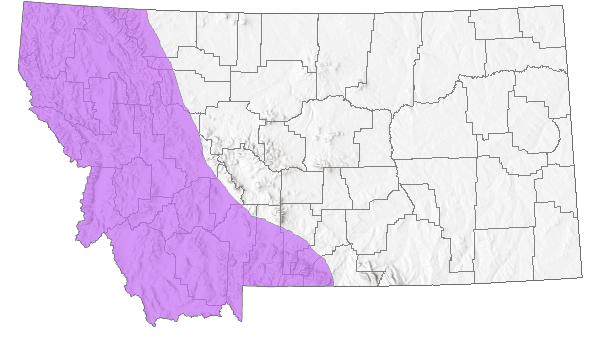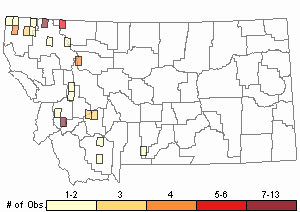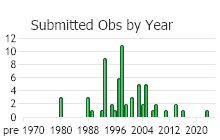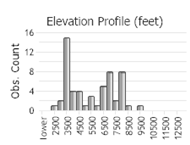View in other NatureServe Network Field Guides
NatureServe
Montana
Utah
Wyoming
Idaho
Wisconsin
British Columbia
South Carolina
Yukon
California
New York
Peculiar Moonwort - Botrychium paradoxum
State Rank Reason (see State Rank above)
This moonwort species is known to occur in western Montana from over two dozen extant occurrences, almost all of which are on federally-managed lands. Many occurrences are small in size and occupy mesic meadows and bunchgrass communities. Potential impacts to the these sites include livestock grazing, weed invasion and recreational uses. Though some threats exist to individual occurrences, the species as a whole is not highly threatened by any single or combination of potential impacts in the state.
- Details on Status Ranking and Review
Population Size
Score2 - Small: Generally 2,000-10,000 individuals.
Range Extent
Score1 - Peripheral, Disjunct or Sporadic Distribution in MT: Widespread species that is peripheral, disjunct or sporadically distributed within MT such that it occurs in <5% of the state (<7,500 sq. miles or the combined area of Beaverhead and Ravalli Counties) or is restricted to 4-5 sub-basins.
CommentRegional endemic from south central Utah, northward to Montana
and Washington and into southern British Columbia, Alberta and Saskatchewan
Area of Occupancy
Score1 - Moderate: Generally occurring in 11-25 Subwatersheds (6th Code HUC’s).
Environmental Specificity
Score1 - Moderate: Species is restricted to a specific habitat that is more widely distributed or to several restricted habitats and is typically dependent upon relatively unaltered, good-quality habitat (C Values of 5-7).
Long-term Trend
CommentTrend data lacking, though probably relatively stable with fluctuating population levels.
Trends
Score0-1 - Stable to Minor Declines:
CommentTrends are undocumented, though populations are likely stable or experiencing only minor declines.
Threats
Score1 - Medium: 11-30% of the populations are being negatively impacted or are likely to be impacted by one or more activities or agents, which are expected to result in decreased populations and/or habitat quality and/or quantity.
CommentWeed invasion may negatively impact some populations.
Intrinsic Vulnerability
Score1 - Moderate Vulnerability: Specific biological attributes, unusual life history characteristics or limited reproductive potential makes the species susceptible to extirpation from stochastic events or other adverse impacts to its habitat and slow to recover.
Raw Conservation Status Score
Score
7 to 8 total points scored out of a possible 19.
General Description
Peculiar moonwort is a small perennial fern with a single above ground frond. The frond varies in height up to about 15 cm tall, is glaucous green, somewhat succulent, and divided into two similar segments which share a common stalk. The segments may be unbranched in small plants or branched in larger plants and are both fertile and bear grape-like sporangia. Spores germinate underground and develop into minute, subterranean, non-photosynthetic gametophytes which depend on an endophytic fungus for nourishment.
Phenology
Fronds mature in July.
Diagnostic Characteristics
Botrychium paradoxum is perhaps the easiest of moonworts to recognize, being the only species to lack a sterile laminar frond segment, but other species could be mistaken for it if the sterile segment has been browsed or bears marginal sporangia. Reliable field determination of moonworts depends on the careful use of technical keys and comparison with silhouette outlines of verified specimens. It is complicated because there is often a high degree of morphological variability between individuals in a population and between populations of the same species, several species may grow together at the same site, and the few diagnostic characters may not be apparent in small plants.
Species Range
Montana Range
Range Descriptions

 Native
Native
Range Comments
In MT from Lincoln County east to Sweet Grass County; southern BC to SK (barely) south through WA, ID, MT, WY, CO, and UT, with a disjunct occurrence in east-central CA (Donald Farrar, Iowa State Univesity, unpublished ms.)
Observations in Montana Natural Heritage Program Database
Number of Observations: 66
(Click on the following maps and charts to see full sized version)
Map Help and Descriptions
Relative Density

Recency



 (Observations spanning multiple months or years are excluded from time charts)
(Observations spanning multiple months or years are excluded from time charts)
Habitat
Mesic meadows associated with spruce and lodgepole pine forests in the montane and subalpine zones; also found in springy western red cedar forests.
National Vegetation Classification System Groups Associated with this Species
Alpine
Alpine - Sparse and Barren
Alpine - Vegetated
Forest and Woodland
Deciduous Forest and Woodland
Montane - Subalpine Forest and Woodland
Shrubland
Sagebrush Shrubland
Grassland
Montane - Subalpine Grassland
Wetland and Riparian
Riparian and Wetland Forest
Stewardship Responsibility
References
- Additional ReferencesLegend:
 View Online Publication
View Online Publication
Do you know of a citation we're missing? Ahlenslager, K. and P. Lesica. 1996. Observations of Botrychium x watertonense and its putative parent species, B. hesperium and B. paradoxum. American Fern Journal 86(1):1-7.
Ahlenslager, K. and P. Lesica. 1996. Observations of Botrychium x watertonense and its putative parent species, B. hesperium and B. paradoxum. American Fern Journal 86(1):1-7. Farrar, Donald. 2011. Moonwort (Botrychium) Systematics. Ada Hayden Herbarium. Iowa State University.
Farrar, Donald. 2011. Moonwort (Botrychium) Systematics. Ada Hayden Herbarium. Iowa State University. Ferriel, Roger D. 2001. A conservation strategy for the six sensitive species of Botrychium on the Kootenai National Forest. M.S. Thesis. University of Montana. Missoula, MT.
Ferriel, Roger D. 2001. A conservation strategy for the six sensitive species of Botrychium on the Kootenai National Forest. M.S. Thesis. University of Montana. Missoula, MT. Lesica, P. and K. Ahlenslager. 1995. Demography and life history of three sympatric species of Botrychium subg. Botrychium in Waterton Lakes National Park, Alberta, Canada. Draft manuscript prepared in cooperation with Waterton National Park, U.S. Fish and Wildlife Service, and Montana Natural Heritage Program. 22 pp.
Lesica, P. and K. Ahlenslager. 1995. Demography and life history of three sympatric species of Botrychium subg. Botrychium in Waterton Lakes National Park, Alberta, Canada. Draft manuscript prepared in cooperation with Waterton National Park, U.S. Fish and Wildlife Service, and Montana Natural Heritage Program. 22 pp. Lesica, P., M.T. Lavin, and P.F. Stickney. 2012. Manual of Montana Vascular Plants. Fort Worth, TX: BRIT Press. viii + 771 p.
Lesica, P., M.T. Lavin, and P.F. Stickney. 2012. Manual of Montana Vascular Plants. Fort Worth, TX: BRIT Press. viii + 771 p. Lesica, P., M.T. Lavin, and P.F. Stickney. 2022. Manual of Montana Vascular Plants, Second Edition. Fort Worth, TX: BRIT Press. viii + 779 p.
Lesica, P., M.T. Lavin, and P.F. Stickney. 2022. Manual of Montana Vascular Plants, Second Edition. Fort Worth, TX: BRIT Press. viii + 779 p. Mantas, M. and R.S. Wirt. 1995. Moonworts of western Montana (Botrychium subgenus Botrychium). Flathead National Forest. 103 pp.
Mantas, M. and R.S. Wirt. 1995. Moonworts of western Montana (Botrychium subgenus Botrychium). Flathead National Forest. 103 pp. Vanderhorst, J.P. 1993. Survey for Botrychium paradoxum in the vicinity of Storm Lake, Deerlodge National Forest. Unpublished report to the U.S. Fish and Wildlife Service. Montana Natural Heritage Program, Helena. 45 pp.
Vanderhorst, J.P. 1993. Survey for Botrychium paradoxum in the vicinity of Storm Lake, Deerlodge National Forest. Unpublished report to the U.S. Fish and Wildlife Service. Montana Natural Heritage Program, Helena. 45 pp. Wagner, D.H. 1992. Guide to the species of Botrychium in Oregon, November 1992. Unpublished report. USDA Forest Service 19 pp., plus figures.
Wagner, D.H. 1992. Guide to the species of Botrychium in Oregon, November 1992. Unpublished report. USDA Forest Service 19 pp., plus figures. Wagner, Jr., W.H., F.S. Wagner, C. Haufler and J.K. Emerson. 1984. A new nothospecies of moonwort (Ophioglossaceae, Botrychium). Canadian Journal of Botany 62:629-634.
Wagner, Jr., W.H., F.S. Wagner, C. Haufler and J.K. Emerson. 1984. A new nothospecies of moonwort (Ophioglossaceae, Botrychium). Canadian Journal of Botany 62:629-634. Wagner, W. H. and F. S. Wagner. 1993. Ophioglossaceae. In: Flora of North America Editorial Committee, eds. 1993. Flora of North America North of Mexico. 3+ vols. New York and Oxford. Vol. 2, pp. 85-106.
Wagner, W. H. and F. S. Wagner. 1993. Ophioglossaceae. In: Flora of North America Editorial Committee, eds. 1993. Flora of North America North of Mexico. 3+ vols. New York and Oxford. Vol. 2, pp. 85-106. Wagner, W.H., and F.S Wagner. 1981. New Species of Moonworts, Botrychium Subgenus. Botrychium, From American Fern Journal 71:20-30.
Wagner, W.H., and F.S Wagner. 1981. New Species of Moonworts, Botrychium Subgenus. Botrychium, From American Fern Journal 71:20-30. Zika, P. F. 1994. A draft management plan for the moonworts Botrychium ascendens, B. crenulatum, B. paradoxum, and B. pedunculosum in the Wallowa-Whitman, Umatilla, and Ochoco National Forests. Unpublished report. Oregon Natural Heritage Program, Portland, OR. 41 pages plus figures, tables and appendices.
Zika, P. F. 1994. A draft management plan for the moonworts Botrychium ascendens, B. crenulatum, B. paradoxum, and B. pedunculosum in the Wallowa-Whitman, Umatilla, and Ochoco National Forests. Unpublished report. Oregon Natural Heritage Program, Portland, OR. 41 pages plus figures, tables and appendices.
- Web Search Engines for Articles on "Peculiar Moonwort"





